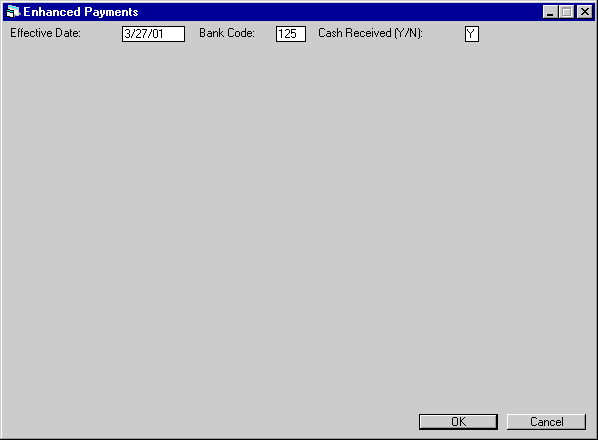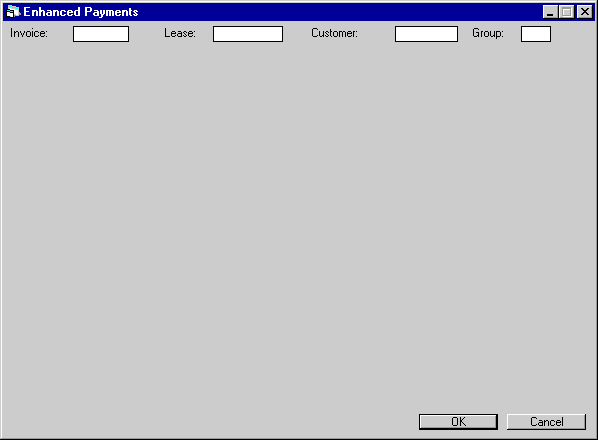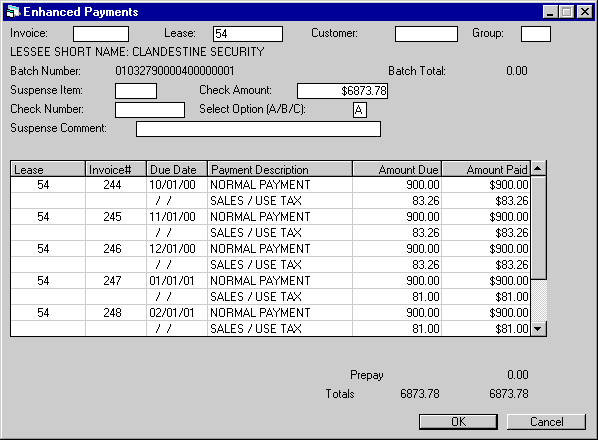Payments [U0102]: Enhanced Payments
 This update is part of the Payments [U0102]
group of updates. For an introduction to Payments and links to all the Payments documents, refer to
Payments [U0102].
This update is part of the Payments [U0102]
group of updates. For an introduction to Payments and links to all the Payments documents, refer to
Payments [U0102].
Contents
Introduction

This is the first screen to appear when the Enhanced Payments option is selected from the Payment menu.
- EFFECTIVE
DATE
Today’s date defaults in MM/DD/YY or DD/MM/YY format, depending on the Date Format Preference field in Security [U0706]. It may be overridden with a past or future date, if desired.Note: The following error message will appear and prevent the payment from being processed when the effective date prior to the lease commencement date: PAYMENT EFFECTIVE DATE [MMDDYYor DD/MM/YY] IS LESS THAN LEASE DATE [MMDDYY or DD/MM/YY].
Payments that are received through Lock Box will be placed in Suspense [U0109] for manual review.
- BANK
CODE
This field appears only if the Multiple Banks module has been purchased. It allows the user to specify which bank should receive the payment. The default Bank code is 125. Valid entries are 1 or 125-144.
- CASH
RECEIVED
The default is Y. Change to N if payment will be applied from suspense.
Selection

This screen is used to select the account(s) to which payment will be applied. The selection may be accomplished by invoice number, by lease number, or by a combination of customer and group numbers.
Enhanced Payment may not be used for interest bearing loans.
- INVOICE NUMBER
Enter the invoice number to which payment will be applied. Leave blank if selecting a customer/group. If an invoice is entered and the lease associated with that invoice has additional open invoices, all open invoices appear on subsequent screens. If the invoice entered has already been paid, the lease number associated with that invoice appears, along with an error message ("Invoice is not outstanding.")
- LEASE
Enter the lease number if payment to a lease is desired. Leave blank if selecting a customer/group. Whether invoice number or lease number is entered, identical information appears on subsequent screens. All open invoices for the lease appear.When a Suspense item is tied to a lease, LeasePak will display the Suspense balance and Suspense number associated with the lease or invoice number entered. The following screen will display:
This enhancement does not support batch processes, Customer/Group or changes/additions made through G/L Adjustments [U0121].
- CUSTOMER
Enter the customer number if payment to a customer/group is desired. Leave blank if selecting a specific invoice or lease. GROUP must be entered if CUSTOMER is entered.
- GROUP
Enter the group number if payment to a customer/group is desired. Leave blank if selecting a specific invoice or lease. CUSTOMER must be entered if GROUP is entered.
Payment
Processing

This screen is used to process payments for the invoice, lease or customer/ group specified. The payment may be a check received or an amount from suspense.
This screen is displayed if:
- An invoice number was entered on screen 2 and the invoice is outstanding, or
- A lease number was entered on screen 2 and there is an outstanding invoice for the lease, or
- A customer/group combination was entered on screen 2 and there is an outstanding invoice for the group, and
- The lease is a not an interest bearing loan.
With the 1994 JULE Fund enhancements it is possible to produce advanced invoices independent of their accrual dates. Such invoices do not accrue, are not reflected on the G/L, until the number of days after due date set as ACCRUAL DEFERRAL DAYS for the portfolio. Before advanced invoices accrue they do not appear on the enhanced payment screens.
- BATCH
NUMBER
This field appears if the Cash Control module is purchased. For Cash Control, LeasePak automatically assigns unique 30-digit batch numbers to each check applied through [U0102PA]. It is later possible to display all the line item amounts paid by a check on the Cash Control Batch Number Payment Reversal screen, even if they are from multiple leases and/or invoices.When entering payments on [U0102PA], apply the full amount of a check to all leases/invoices to be paid by that check, putting overpayments into pre-payment or suspense, before entering a new check. Batch number changes when a new CHECK NUMBER is entered below.
Batch numbers assigned by LeasePak are made up of 20digits:
- 6 digits for current date (YYMMDD)
- 6 digits for each payment session
- 8 digits for each check. This number increases each time a new check number is entered.
For example, 3 checks from 3 lessees are to be applied on September 3, 1995.CHECK NO.
CHECK AMT.
INVOICE NO.
AMT PAID
BATCH NO.
1011
$250
10042
$100
9509039000010000001
same
10191
$100
9509039000010000001
same
10233
$50
9509039000010000001
976
$7005
09919
$7005
9509039000010000002
9442
$2224
10098
$1112
9509039000010000003
same
10131
$1112
9509039000010000003
If the user leaves the Payment screen back to the main menu, and then goes back to enter more payments, the next batch number will start with:
090390000200000001
Payments on Interest Bearing Loans are now supported. However, a new batch number is assigned for each IBL payment even for the same check number. This prevents cascading results in IBL payment Reversals.
Payments by customer/group are not assigned batch numbers; they are not supported by Cash Control.
Note: Batch numbers may also be included in input files for batch payments processed through end of period [U0415] and through interactive Batch Payments [U0305]. If batch numbers are used for Batch Payments, they must be assigned by the lockbox or other entity creating the batch payment files. The format of batch numbers remains the same, 20 digits made up of date, batch number and check sequence number. It is important that numbers assigned by a lockbox not duplicate those assigned by LeasePak for manually processed payments on the same day. For the 6digit batch sequence number use: 000001 - 900000. This is why online Payment batch sequence numbers start with 9000001.
- BATCH
TOTAL
This field appears if the Cash Control module is purchased. LeasePak adds a running total of all payments with the same check number. The total should match the actual check amount before a new check number is entered.
- LESSEE
SHORT NAME
The lessee short name is displayed. When a customer/group has been selected, the group name is displayed.
- SUSPENSE
ITEM
Either a check received or a payment previously put in suspense may be applied. To apply an amount from suspense, enter the item number as it appears on the Suspense Review report [R0203].
- CHECK
AMOUNT
Enter the CHECK AMOUNT of the payment received. The total AMOUNT DUE defaults and may be overridden with the actual payment amount.When the 1996 Jule Fund module is purchased, the DEFAULT DISPLAY OF PAYMENT AMOUNT switch in the Miscellaneous Customizations option of the Portfolio [U0212] update, is set to ‘N’ the total amount of unpaid receivables due will not default in the field; therefore, allowing the payment amount to be manually entered.
- CHECK
NUMBER
Enter the check number for reference. It may be up to 10 digits. This number appears on the Account Payment History report [R0909].If Cash Control module has been purchased, the check number is required. LeasePak will store the check number in the Check Payment Master (RPM) file and Check Payment Detail (RPN) file. A trace reference will be created based on the Payment Origination code: ‘LPPA’ for Enhanced Payments[U0102]. The trace reference will be displayed in the Cash Control Payment History [R0926] report.
- SELECT
OPTION (A/B/C)
Help is available on this field.A APPLY CASH / PREPAY
Apply cash received against all outstanding invoices, with any overpayment applied as a pre-payment.B SUSPENSE
Apply cash received to suspense.
C APPLY CASH / SUSPENSE
Apply cash received against all outstanding invoices, with any overpayment applied to suspense.When option A is chosen, a field titled PREPAYMENT appears at the bottom of the screen. For options B or C, that field’s name changes to SUSPENSE. With options A or C, all outstanding items must be paid in full before the remaining cash goes to pre-payment or suspense.
The default option for customer/group payments is C; option A is not allowed for customer/group payments.
- SUSPENSE
COMMENT
Comments may be entered if option B or C is chosen. Those comments will appear on the Suspense Review report.
- LEASE
Scroll through a maximum of 5000 lines of open receivables. When invoice or lease number was entered on screen 2, all open invoices for the lease appear, starting with the oldest. When a customer/group was entered, each receivable for all leases in the group which have open invoices appear, starting with the lowest lease number.
- INVOICE NUMBER
All invoices with open receivables for the lease appear, starting with the earliest due date.
- DUE
DATE
The due date(s) of the invoice(s) appear in MM/DD/YY or DD/MM/YY format, depending on the Date Format Preference field in Security [U0706].
- PAYMENT
DESCRIPTION
The type of open receivable is displayed according to a payment hierarchy. All open receivables of the type at the top of the hierarchy (usually normal payments) will be paid first, unless the AMOUNT PAID is overridden by the user. When a partial payment is made, receivables are paid according to the hierarchy until all the partial payment has been applied.A customized hierarchy may be established on the Assessments Customization screen of the Portfolio update [U0212], if the Rename Assessments at the Portfolio Level module has been purchased. Otherwise, LeasePak’s default hierarchy is:
- Rent (Normal Payment)
- Sales / Use Tax
- Late Charges
- Property Tax
- Other Assessments, Recurring Charges
If the lease is simple interest or precomputed accrual type and in a suspended earnings status, and the due date of the invoice is after the effective date of the earnings suspension, SUSPENDED PRINCIPAL and SUSPENDED INTEREST are displayed in place of NORMAL PAYMENT. Default cash application assignments are displayed for both components. Cash may be applied to either in the same fashion as to NORMAL PAYMENT.
If the lease is an operating lease and in a suspended earnings status, and the due date of the invoice is after the effective date of the earnings suspension, SUSPENDED INTEREST is displayed in place of NORMAL PAYMENT.
If the lease is extended using the RES method, NORMAL PAYMENT corresponds to any remaining residual. INTEREST corresponds to any income in excess of residual, i.e., the residual is completely amortized. The income and residual normally recognized at the time this invoice was created may have been deferred if cash basis accounting was used. In this case, the income and residual would be recognized now, when the payment was actually received. Refer to the RES accrual method in the Reference Guide Calculations document for more information on this accrual method.
If the lease is a variable rate operating lease (accrual type AOVE or ROVE), the lessee is billed the combined principal and interest amounts from the original payment schedule, as entered on Book Lease [U0101], adjusted for interest changes based on the float rate. When the invoice appears on the Payment update, NORMAL PAYMENT corresponds to the principal portion of the scheduled payment, and INTEREST corresponds to the interest portion of the scheduled payment and the interest adjustment.
- AMOUNT
DUE
All unpaid receivables are displayed.When the 1996 Jule Fund module is purchased and the DEFAULT DISPLAY OF PAYMENT AMOUNT switch in the Miscellaneous Customizations option of the Portfolio [U0212] update, is set to ‘N’ the CHECK AMOUNT should be manually entered and the AMOUNT DUE field will default the amount being applied to the lease.
- AMOUNT
PAID
The amount to apply for each charge defaults to the AMOUNT DUE when the screen is initially displayed, until the CHECK AMOUNT or the amount of the SUSPENSE ITEM is used up.If the total amount to apply is less than the total AMOUNT DUE, then payments are defaulted according to the hierarchy established for the portfolio on [U0212], or according to LeasePak’s standard hierarchy if no other is established. AMOUNT PAID defaults for all open receivables at the top of the hierarchy first, from oldest to most recent. Then payment defaults for receivables second in the hierarchy, and so forth until the full amount to be applied defaults.
- PREPAY
If option A was entered and the total amount to apply is more than the total AMOUNT DUE, the remainder is displayed to be applied as a pre-payment. The user may not change this amount. Pre-payments are processed for lease/ invoice, but not for customer/group.A switch on the Miscellaneous Customizations screen of the Portfolio update [U0212] influences both Enhanced Payments and normal Payments.
- SUSPENSE
If option C was entered and the total amount to apply is more than the total AMOUNT DUE, the remainder appears to be put into suspense.The user may not change this amount.
- TOTALS
After scrolling through all charges and overriding defaults as desired, the TOTAL AMOUNT TO APPLY must equal the CHECK AMOUNT or amount of the SUSPENSE ITEM. If not, an error message appears and the payment cannot be processed.
LeasePak Reference Guide
©
by McCue Systems Incorporated. All rights reserved.
The information contained in this document is the property of McCue Systems, Inc. Use of the information contained herein is restricted. Conditions of use are subject to change without notice. McCue Systems, Inc. assumes no liability for any inaccuracy that may appear in this document; the contents of this document do not constitute a promise or warranty. The software described in this document is furnished under license and may be used or copied only in accordance with the terms of said license. Unauthorized use, alteration, or reproduction of this document without the written consent of McCue Systems, Inc. is prohibited.
